Эгломизе
Эгломизе(Verre églomisé, eglomise)

ЭГЛОМИЗЕ́ - техника декора, изображение с обратной стороны стекла. Чаще всего эгломизе украшались рамы картин и зеркал, детали мебели.

Есть живопись "на стекле" (с лицевой стороны ) и «под стеклом» с оборотной стороны стекла. Эти две категории различаются принципиально разным подходом и сложностью.

Если при живописи "на стекле" краски наносятся классическим способом, также как и на другие основы, то при живописи "под стеклом" сначала выполняются все детали, а только затем - фон. Пишут от переднего плана к заднему, сначала блики и ярчайшие света и глубокие тени, потом средние тона.
Это очень сложно для художника.
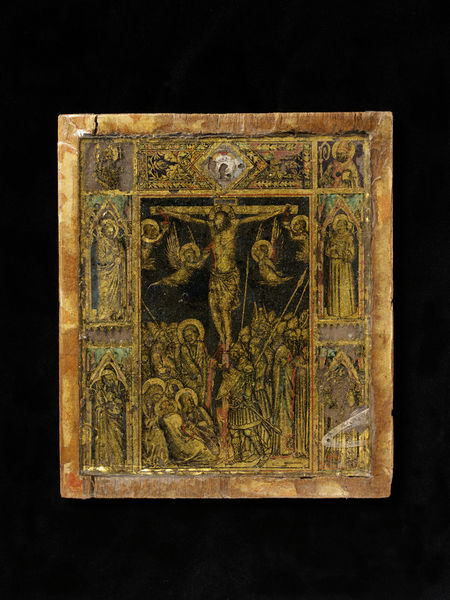
Crucifixion
Umbria (probably, made)
1370-1380
Термин «эгломизе» - первоначально «гломизе» появился в лексиконе французских антикваров второй половины XVIII века: он явился производным от имени парижского рисовальщика и изготовителя рам Жана Батиста Гломи (Jan Baptiste Glomi). Считалось, что он первым использовал особую технику живописи на стекле, с применением золотой и серебряной фольги для обрамления графических листов стеклянными рамами.
Термин получил широкое распространение в XIX веке и применялся к таким образцам живописи «под стеклом», которые были гораздо старше, чем Ж.Б. Гломи.
Самые ранние произведения, близкие по технике исполнения к эгломизе, датируются III веком до нашей эры, когда такого термина еще не существовало. Это - стеклянные сосуды, состоящие из двух частей, внешней и внутренней, между которыми заключен рисунок, выгравированный из листового золота. Древнего названия этой техники не сохранилось.
Техника эгломизе относится к разряду «холодной» живописи «под стеклом».
Но, строго говоря, ее нельзя отнести к чисто живописным техникам, так как основной ее составляющей является нанесение на стекло при помощи какого-либо прозрачного клея металлической фольги (чаще всего используется листовое золото, но встречаются работы с листовым серебром и даже цинковой фольгой) с последующей гравировкой по ней рисунка тонкой иглой. После удаления фольги с тех мест, где должно быть видно изображение, прямо на фольгу наносится какая-либо краска. Вследствие этих операций на лицевой стороне стекла можно
увидеть черный (или какого-нибудь другого цвета) рисунок на золотом (серебряном и т.п.) фоне.

LORENZO Monaco
Virgin and Child Enthroned with Sts John the Baptist and John the Evangelist
1390s
Gold foil and oil paint on glass, 17 x 18 cm
Musée du Louvre, Paris
В средние века эгломизе использовали в декоре церковной утвари и украшений:
-------------------------------

Reliquary of Mary Magdelene, 14th or 15th Century Tuscany, Italy
Courtesy of the Metropolitan Museum of Art
----------------------

Pendant
Unknown
1470-1480
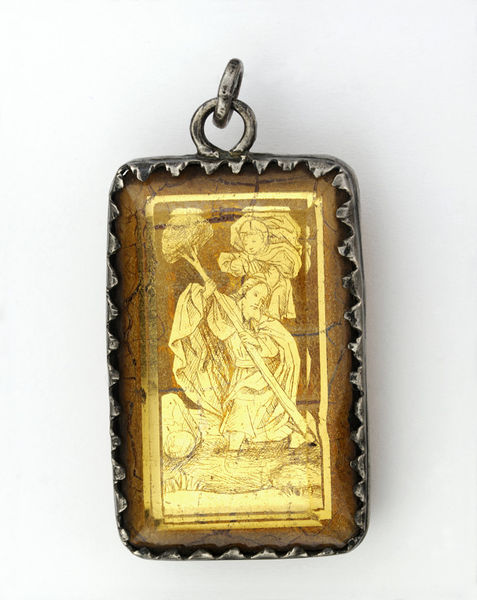
The technique used here is known as 'verre églomisé', even though in this case rock crystal has been used instead of the more usual glass.
---------------------------
Техника эгломизе сначала
использовалась, в основном, для создания миниатюр.
В большинстве это портретные силуэтные миниатюры, оформлявшиеся в качестве медальонов и служившие как вставки в табакерки или различного рода коробочки, небольшие вещи.

Солонка (Тюдоры)
Unknown
1592-1593
This 'salt' is a large, ceremonial object which would have been placed in front of the head of the household or the guest of honour as a container for salt during a meal. Salts were among the most important pieces of metalwork in a Tudor or Stuart household.
----------------------------
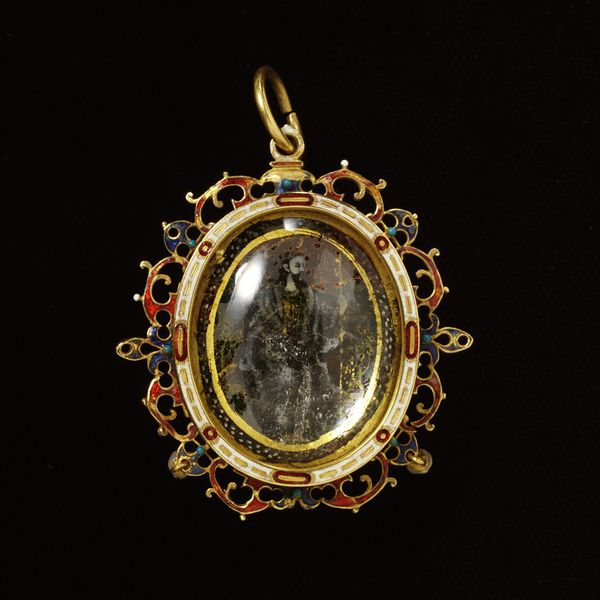
Pendant
Unknown
1550-1600

Plaque
Unknown
1600-1620
---------------------------
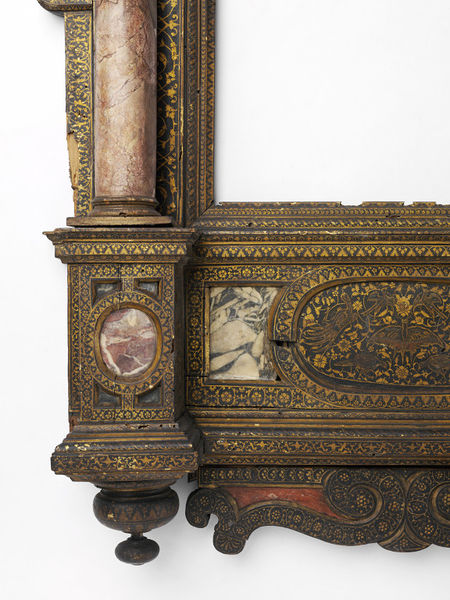
Frame
1600-1700
----------------ПАННО------------------
=============================================
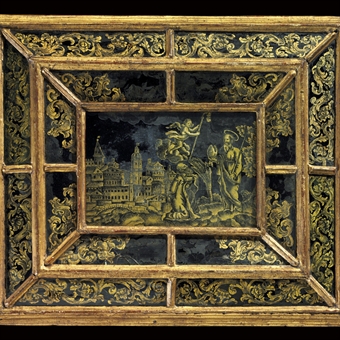
A SOUTH EUROPEAN GILTWOOD AND VERRE EGLOMISE PANEL
MID-18TH CENTURY
----------------Живопись-17 век---------------
================================================
Были виртуозы этой техники, методом "наоборот" создавались настоящие картины:

Painting on glass
Verre églomisé; chased gilt bronze frame
Unknown
1660-75
This brilliant jewel-like image depicts the conversion of Mary Magdalen
---------------------

Eglomisé mit allegorischer Darstellung der Prüfung des Glaubens. Zürich, um 1610-1620. Hinterglasgemälde, 33,5 cm x 42,5 cm
Schweizerisches Nationalmuseum, Zürich
Date
c. 1610-1620
------------------------

Jan van der Heyden (1637-1712)
View in the woods.
Date
between 1660(1660) and 1690(1690)
Verre églomisé
--------------------18 век------
---------------------------------

Зеркала
Pair of Early 18th Century Venetian Verre Eglomise Mirrors
Venice Italy
Circa 1720
Rare Pair of Venetian Reverse Painting on Glass Mirrors. Mythological scenes

Apotheose der Helvetia, mit den 13 Wappen der alten Orte. Hinterglasgemälde (Eglomisé), 26 cm x 33.5 cm
Schweizerisches Nationalmuseum, Zürich,
1773
--------------------Графика-18 век---------------

Jonas Zeuner (1727-1814)
1796
Verre églomisé.

Jonas Zeuner (1727-1814)
Dutch stained-glass artist, painter and draughtsman
Title
Pupils lined up at the Zeerecht building in Amsterdam.
Date 1796
Verre églomisé.
(Inventory)Rijksmuseum Amsterdam
----------------Картины------------

English 18thc Eglomise English Bird Hunting Painting

"The Bury Hunt", lithograph, originally painted by C. Agar and engraved by F. Bromley. Eglomise matte.

19th Century print Eglomise

-----------------------Силуэты--------------------------------

Églomisé -
Ca. 1790,(18,5 x 11,8 cm)

Silhouette ca.1820
----------------Табакерки----------
================================

Snuffbox
Blerzy, Joseph-Etien
1789-1790
Villar (panels, artist)
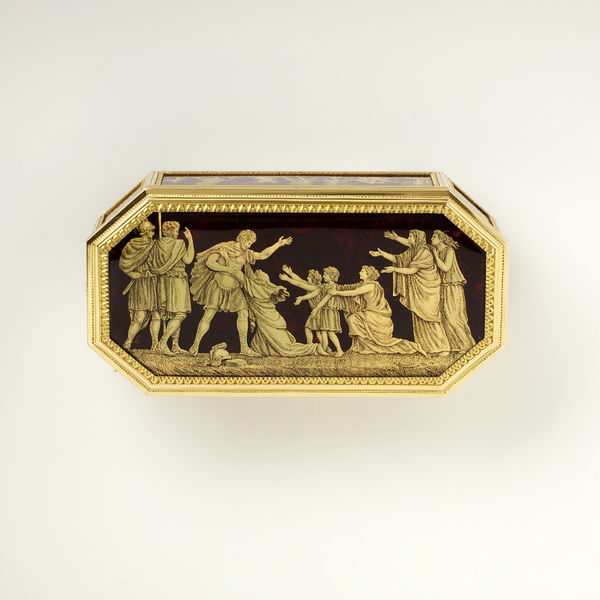
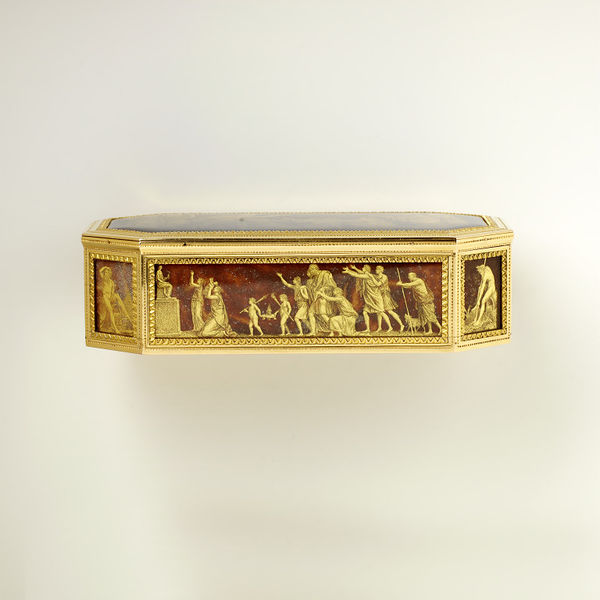
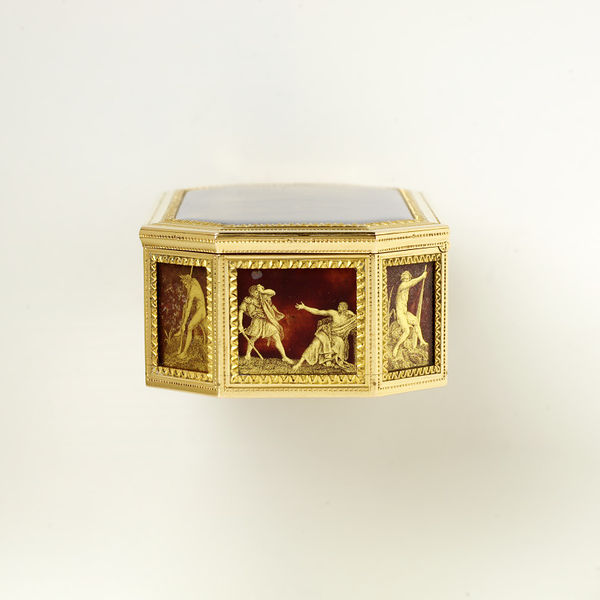
-----------------------------------
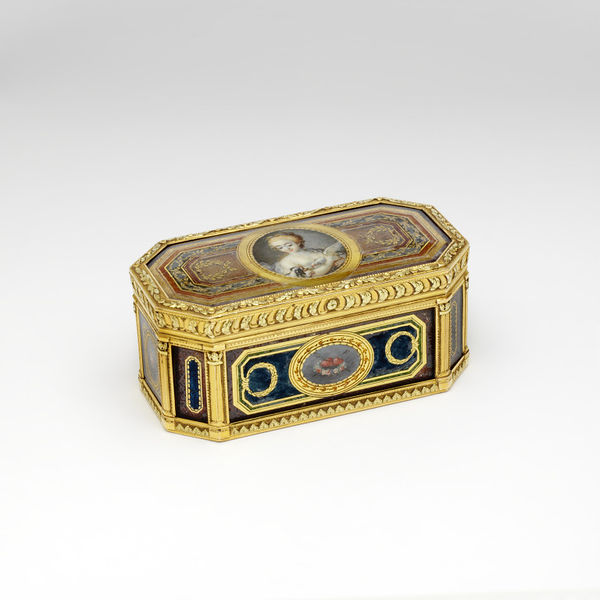
This box has been painted with symbols of love - a girl holding a dove and on the base, flowers, a dove, a quiver of arrows and a harp. The background of the box is painted to resemble guilloché enamel.
------------------------МЕБЕЛЬ-----------------
=========================================================
Постепенно эгломизе стали применять в декорировке больших вещей: стеклянных вставок в мебели и столешницах.
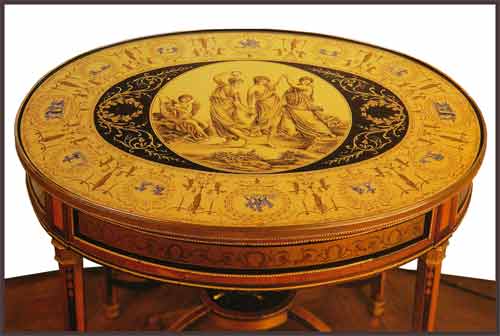
Х.Мейер. Столик со столешницей, расписанной в технике эгломизе. 1770-1780-е годы. Государственный музей-заповедник «Павловск»

Столик со стеклянной столешницей с изображением сцены поклонения волхвов , Конец 18 в.
Россия. Эрмитаж.
--------------------Мебель------------------
==============================================

Бюро
Россия, Санкт-Петербург. Мастерская Г. Гамбса (?).
1800-е

Дуб (основа), красное дерево, латунь, бронза, стекло, сафьян; фанеровка, эгломизе
----------------------------------------
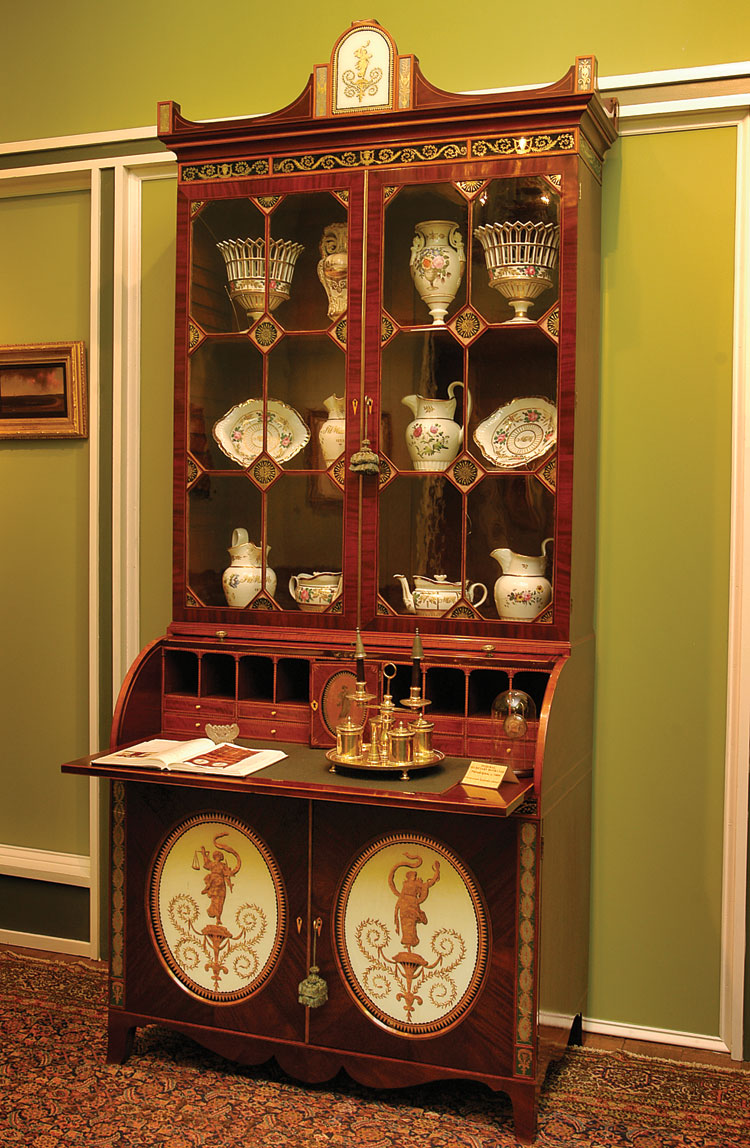
Rare Philadelphia Federal inlaid and églomisé secretary bookcase, circa 1800.
---------------------------------------

Stunning Scarlet Chinoiserie Queen Anne Style Cabinet
Continental
19th C
Unusual Stunning Queen Anne Style Chinoiserie decorated China Cabinet or display cabinet vitrine with eglomise rooster panels

-------------------Столики---------------
=============================================
----------------------------

An elaborate neoclassical side table in giltwood, ormolu and eglomise with a marble top and a center eglomise panel with a child and a lion that the catalog noted may have been Russian realized $25,740.
-------------------------

A George III Period Pedestal Base Side Table with Flip Top
United Kingdom
Circa 1820

top with later inset verre eglomise decorated surface depicting Chinoiserie figures in an imaginary landscape.
----------------------------------

Table with 'Etruscan' Decor in Verre Eglomise
Italy, late 18th - early19th century
Moulded, carved and gilded wood; verre eglomese H. 90.5cm
1930
-------------------------

Venetian giltwood & verre eglomise silvered oval two tier cocktail table
---------------------------

cream-painted and parcel-gilt, and Verre eglomise console
FRANCE
------------------Зеркальная мебель------------
================================================
-----------------------20 век--------------------------------

Прикроватные тумбочки
Pair of Hollywood Regency night stands; gilt and mirrored surfaces with reverse painted floral designs.
--------------------------------

Eglomise and Lucite Cabinet
A fabulous cabinet of gorgeous design, decorated in etched silver with ormulu detail, featuring lift-up top, mirrored interior with secret compartments, eight drawers and set-back cupboard.
Italy C. 1920's
---------------------

An Eglomise Veneered Vanity/Desk by New Era Glass
United States
1930's
------------------------------------------------

Serge Roche Eglomise Mirrored Cabinet
France
1940s
---------------------------------------------------

Four panel eglomise screen
United States
1940's

A screen depicting Classical figures against a silver leaf ground with gold gilt details
---------------------

Maison Jansen 2-Door Cabinet
France
1920s
Fine French Louis XV style limed-oak cabinet, circa 1920s

--------------------------

In Directoire style with Mahogany

----------------ЗЕРКАЛА---------------
===========================================
------------------18 век---------------------
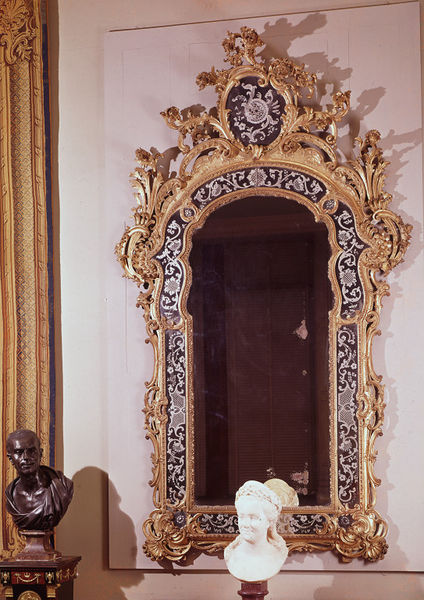
Mirror
Unknown
1735-1740
----------------------------------------

Pair of 19th Century Eglomise Venetian Mirrors
Italy

19th Century
Eglomise Venetian Mirrors. Original Gilt and Gesso Frames
----------------------------------

Classical Giltwood Mirror with Eglomise Panel of Mt. Vernon
American
c.1820

------------------------
------------------Federal_Mirrors----------------
==========================================================

Federal Gilt Wood Mirror with Eglomise Tablet
America
Ca. 1815-1820

--------------------------------------------------

Pair of English Edwardian Giltwood Mirrors
England
Circa 1910
-----------------------

American Federal Eglomise And Carved Mirrors
American
19th c
--------------------------------------

Italy
C.1920

Stunning Antique Italian Parcel Gilt Adams Mirror, with Eagle, urns, Lion Paw with inset of Roman scene on terracotta eglomise panel.
------------------------------------------------

Verre Eglomise Wall Mirror
France
1940's

Hollywood Regency Mirror w/ Eglomise Design c. 1940's
-----------------Светильники-Лампы---------------
----------------------------------

Pair Jansen Eglomise Oval Sconces
France
late 19th century/early 20th century

--------------------------
-1.JPG)
A pair of glass gilded lamps, Pitti décor, circa 1940.
-1.JPG)
Glass gilded lamp, antique décor, circa 1940.
--------------------------------

Pair of Eglomise Chinoiserie Lamps
circa 1950
-----------------------------

France
1970s
Two 1970s lamps in eglomised glass with gilt and silver tone, decorated with antique figures set in medallions.



-----------------------

An Eglomise Lamp, 20th Century

-------------------

eglomise glass lamp with classical decoupage figure of Alexander the Great atop his black stallion Bucephalas, against tortoise-shell reverse painted background.
1940
Еще по теме:
=================================


Венецианские зеркала и зеркальная мебель-ТУТ


ЗЕРКАЛА, все посты-ТУТ
=============================
Verre églomisé, from the French term meaning glass gilded, is a process in which the back side of glass is gilded with gold or metal leaf.
In one method, the metal is adhered using a gelatin adhesive, which results in a mirror-like, reflective finish in which designs are then engraved. The metal leaf may be applied using oil-based adhesives (goldsize varnish) to achieve a matte finish. The gilding may also be combined with reverse painting on glass.
The technique dates back to the pre-Roman eras, but its name is derived from 18th century French decorator and art-dealer Jean-Baptise Glomy (1711-1786) who is responsible for its re-popularization.
One of the key historical periods of the art was in Italy during the 13th to 16th centuries. Small panels of glass with designs formed by engraved gilding were applied to reliquaries and portable altars. The method used is described by Cennino Cennini. It has also been used throughout Europe since the 15th century, appearing in paintings, furniture, drinking glasses and similar vessels and jewelry. It is also often seen in the form of decorative panels of mirrors, clock faces, and in more recent history, as window signs and advertising mirrors.
------------------------------------------------
http://media.vam.ac.uk/
http://www.1stdibs.com/
http://www.antiquesandfineart.com/articles/article.cfm?request=849
http://www.trocadero.com/cgi-bin
/search1.cgi?t=|||Most+Recent|eglomise||thumb||16|15||||no|
http://images.google.ru/images?um=1&hl=ru&newwindow=1&client=firefox&rls=org.mozilla:ru:official&tbs=isch:1&q=EGLOMISE&sa=N&start=105&ndsp=21&biw=1575&bih=863
http://www.google.ru/search?q=%D1%8D%D0%B3%D0%BB%D0%BE%D0%BC%D0%B8%D0%B7%D0%B5&hl=ru&newwindow=1&client=firefox&hs=b5E&rls=org.mozilla:ru:official&biw=1575&bih=891&prmd=ivns&tbm=isch&tbo=u&source=univ&sa=X&ei=t2nwTdvlD4rBswbtq92rAw&sqi=2&ved=0CFQQsAQ
http://www.antiquehelper.com/catalog-search?q=EGLOMISE&page=2&sort=
http://www.nasledie-rus.ru/podshivka/8516.php
---------------
http://www.christies.com/LotFinder/lot_details.aspx?intObjectID=5191920
текст
http://www.lib.ua-ru.net/diss/cont/218580.html

ЭГЛОМИЗЕ́ - техника декора, изображение с обратной стороны стекла. Чаще всего эгломизе украшались рамы картин и зеркал, детали мебели.

Есть живопись "на стекле" (с лицевой стороны ) и «под стеклом» с оборотной стороны стекла. Эти две категории различаются принципиально разным подходом и сложностью.

Если при живописи "на стекле" краски наносятся классическим способом, также как и на другие основы, то при живописи "под стеклом" сначала выполняются все детали, а только затем - фон. Пишут от переднего плана к заднему, сначала блики и ярчайшие света и глубокие тени, потом средние тона.
Это очень сложно для художника.

Crucifixion
Umbria (probably, made)
1370-1380
Термин «эгломизе» - первоначально «гломизе» появился в лексиконе французских антикваров второй половины XVIII века: он явился производным от имени парижского рисовальщика и изготовителя рам Жана Батиста Гломи (Jan Baptiste Glomi). Считалось, что он первым использовал особую технику живописи на стекле, с применением золотой и серебряной фольги для обрамления графических листов стеклянными рамами.
Термин получил широкое распространение в XIX веке и применялся к таким образцам живописи «под стеклом», которые были гораздо старше, чем Ж.Б. Гломи.
Самые ранние произведения, близкие по технике исполнения к эгломизе, датируются III веком до нашей эры, когда такого термина еще не существовало. Это - стеклянные сосуды, состоящие из двух частей, внешней и внутренней, между которыми заключен рисунок, выгравированный из листового золота. Древнего названия этой техники не сохранилось.
Техника эгломизе относится к разряду «холодной» живописи «под стеклом».
Но, строго говоря, ее нельзя отнести к чисто живописным техникам, так как основной ее составляющей является нанесение на стекло при помощи какого-либо прозрачного клея металлической фольги (чаще всего используется листовое золото, но встречаются работы с листовым серебром и даже цинковой фольгой) с последующей гравировкой по ней рисунка тонкой иглой. После удаления фольги с тех мест, где должно быть видно изображение, прямо на фольгу наносится какая-либо краска. Вследствие этих операций на лицевой стороне стекла можно
увидеть черный (или какого-нибудь другого цвета) рисунок на золотом (серебряном и т.п.) фоне.

LORENZO Monaco
Virgin and Child Enthroned with Sts John the Baptist and John the Evangelist
1390s
Gold foil and oil paint on glass, 17 x 18 cm
Musée du Louvre, Paris
В средние века эгломизе использовали в декоре церковной утвари и украшений:
-------------------------------

Reliquary of Mary Magdelene, 14th or 15th Century Tuscany, Italy
Courtesy of the Metropolitan Museum of Art
----------------------

Pendant
Unknown
1470-1480

The technique used here is known as 'verre églomisé', even though in this case rock crystal has been used instead of the more usual glass.
---------------------------
Техника эгломизе сначала
использовалась, в основном, для создания миниатюр.
В большинстве это портретные силуэтные миниатюры, оформлявшиеся в качестве медальонов и служившие как вставки в табакерки или различного рода коробочки, небольшие вещи.

Солонка (Тюдоры)
Unknown
1592-1593
This 'salt' is a large, ceremonial object which would have been placed in front of the head of the household or the guest of honour as a container for salt during a meal. Salts were among the most important pieces of metalwork in a Tudor or Stuart household.
----------------------------

Pendant
Unknown
1550-1600

Plaque
Unknown
1600-1620
---------------------------

Frame
1600-1700
----------------ПАННО------------------
=============================================

A SOUTH EUROPEAN GILTWOOD AND VERRE EGLOMISE PANEL
MID-18TH CENTURY
----------------Живопись-17 век---------------
================================================
Были виртуозы этой техники, методом "наоборот" создавались настоящие картины:

Painting on glass
Verre églomisé; chased gilt bronze frame
Unknown
1660-75
This brilliant jewel-like image depicts the conversion of Mary Magdalen
---------------------

Eglomisé mit allegorischer Darstellung der Prüfung des Glaubens. Zürich, um 1610-1620. Hinterglasgemälde, 33,5 cm x 42,5 cm
Schweizerisches Nationalmuseum, Zürich
Date
c. 1610-1620
------------------------

Jan van der Heyden (1637-1712)
View in the woods.
Date
between 1660(1660) and 1690(1690)
Verre églomisé
--------------------18 век------
---------------------------------

Зеркала
Pair of Early 18th Century Venetian Verre Eglomise Mirrors
Venice Italy
Circa 1720
Rare Pair of Venetian Reverse Painting on Glass Mirrors. Mythological scenes

Apotheose der Helvetia, mit den 13 Wappen der alten Orte. Hinterglasgemälde (Eglomisé), 26 cm x 33.5 cm
Schweizerisches Nationalmuseum, Zürich,
1773
--------------------Графика-18 век---------------

Jonas Zeuner (1727-1814)
1796
Verre églomisé.

Jonas Zeuner (1727-1814)
Dutch stained-glass artist, painter and draughtsman
Title
Pupils lined up at the Zeerecht building in Amsterdam.
Date 1796
Verre églomisé.
(Inventory)Rijksmuseum Amsterdam
----------------Картины------------

English 18thc Eglomise English Bird Hunting Painting

"The Bury Hunt", lithograph, originally painted by C. Agar and engraved by F. Bromley. Eglomise matte.

19th Century print Eglomise

-----------------------Силуэты--------------------------------

Églomisé -
Ca. 1790,(18,5 x 11,8 cm)

Silhouette ca.1820
----------------Табакерки----------
================================

Snuffbox
Blerzy, Joseph-Etien
1789-1790
Villar (panels, artist)



-----------------------------------

This box has been painted with symbols of love - a girl holding a dove and on the base, flowers, a dove, a quiver of arrows and a harp. The background of the box is painted to resemble guilloché enamel.
------------------------МЕБЕЛЬ-----------------
=========================================================
Постепенно эгломизе стали применять в декорировке больших вещей: стеклянных вставок в мебели и столешницах.

Х.Мейер. Столик со столешницей, расписанной в технике эгломизе. 1770-1780-е годы. Государственный музей-заповедник «Павловск»

Столик со стеклянной столешницей с изображением сцены поклонения волхвов , Конец 18 в.
Россия. Эрмитаж.
--------------------Мебель------------------
==============================================

Бюро
Россия, Санкт-Петербург. Мастерская Г. Гамбса (?).
1800-е

Дуб (основа), красное дерево, латунь, бронза, стекло, сафьян; фанеровка, эгломизе
----------------------------------------

Rare Philadelphia Federal inlaid and églomisé secretary bookcase, circa 1800.
---------------------------------------

Stunning Scarlet Chinoiserie Queen Anne Style Cabinet
Continental
19th C
Unusual Stunning Queen Anne Style Chinoiserie decorated China Cabinet or display cabinet vitrine with eglomise rooster panels

-------------------Столики---------------
=============================================
----------------------------

An elaborate neoclassical side table in giltwood, ormolu and eglomise with a marble top and a center eglomise panel with a child and a lion that the catalog noted may have been Russian realized $25,740.
-------------------------

A George III Period Pedestal Base Side Table with Flip Top
United Kingdom
Circa 1820

top with later inset verre eglomise decorated surface depicting Chinoiserie figures in an imaginary landscape.
----------------------------------

Table with 'Etruscan' Decor in Verre Eglomise
Italy, late 18th - early19th century
Moulded, carved and gilded wood; verre eglomese H. 90.5cm
1930
-------------------------

Venetian giltwood & verre eglomise silvered oval two tier cocktail table
---------------------------

cream-painted and parcel-gilt, and Verre eglomise console
FRANCE
------------------Зеркальная мебель------------
================================================
-----------------------20 век--------------------------------

Прикроватные тумбочки
Pair of Hollywood Regency night stands; gilt and mirrored surfaces with reverse painted floral designs.
--------------------------------

Eglomise and Lucite Cabinet
A fabulous cabinet of gorgeous design, decorated in etched silver with ormulu detail, featuring lift-up top, mirrored interior with secret compartments, eight drawers and set-back cupboard.
Italy C. 1920's
---------------------

An Eglomise Veneered Vanity/Desk by New Era Glass
United States
1930's
------------------------------------------------

Serge Roche Eglomise Mirrored Cabinet
France
1940s
---------------------------------------------------

Four panel eglomise screen
United States
1940's

A screen depicting Classical figures against a silver leaf ground with gold gilt details
---------------------

Maison Jansen 2-Door Cabinet
France
1920s
Fine French Louis XV style limed-oak cabinet, circa 1920s

--------------------------

In Directoire style with Mahogany

----------------ЗЕРКАЛА---------------
===========================================
------------------18 век---------------------

Mirror
Unknown
1735-1740
----------------------------------------

Pair of 19th Century Eglomise Venetian Mirrors
Italy

19th Century
Eglomise Venetian Mirrors. Original Gilt and Gesso Frames
----------------------------------

Classical Giltwood Mirror with Eglomise Panel of Mt. Vernon
American
c.1820

------------------------
------------------Federal_Mirrors----------------
==========================================================

Federal Gilt Wood Mirror with Eglomise Tablet
America
Ca. 1815-1820
--------------------------------------------------

Pair of English Edwardian Giltwood Mirrors
England
Circa 1910
-----------------------

American Federal Eglomise And Carved Mirrors
American
19th c
--------------------------------------

Italy
C.1920

Stunning Antique Italian Parcel Gilt Adams Mirror, with Eagle, urns, Lion Paw with inset of Roman scene on terracotta eglomise panel.
------------------------------------------------

Verre Eglomise Wall Mirror
France
1940's

Hollywood Regency Mirror w/ Eglomise Design c. 1940's
-----------------Светильники-Лампы---------------
----------------------------------

Pair Jansen Eglomise Oval Sconces
France
late 19th century/early 20th century

--------------------------
A pair of glass gilded lamps, Pitti décor, circa 1940.
Glass gilded lamp, antique décor, circa 1940.
--------------------------------

Pair of Eglomise Chinoiserie Lamps
circa 1950
-----------------------------

France
1970s
Two 1970s lamps in eglomised glass with gilt and silver tone, decorated with antique figures set in medallions.



-----------------------

An Eglomise Lamp, 20th Century

-------------------

eglomise glass lamp with classical decoupage figure of Alexander the Great atop his black stallion Bucephalas, against tortoise-shell reverse painted background.
1940
Еще по теме:
=================================


Венецианские зеркала и зеркальная мебель-ТУТ


ЗЕРКАЛА, все посты-ТУТ
=============================
Verre églomisé, from the French term meaning glass gilded, is a process in which the back side of glass is gilded with gold or metal leaf.
In one method, the metal is adhered using a gelatin adhesive, which results in a mirror-like, reflective finish in which designs are then engraved. The metal leaf may be applied using oil-based adhesives (goldsize varnish) to achieve a matte finish. The gilding may also be combined with reverse painting on glass.
The technique dates back to the pre-Roman eras, but its name is derived from 18th century French decorator and art-dealer Jean-Baptise Glomy (1711-1786) who is responsible for its re-popularization.
One of the key historical periods of the art was in Italy during the 13th to 16th centuries. Small panels of glass with designs formed by engraved gilding were applied to reliquaries and portable altars. The method used is described by Cennino Cennini. It has also been used throughout Europe since the 15th century, appearing in paintings, furniture, drinking glasses and similar vessels and jewelry. It is also often seen in the form of decorative panels of mirrors, clock faces, and in more recent history, as window signs and advertising mirrors.
------------------------------------------------
http://media.vam.ac.uk/
http://www.1stdibs.com/
http://www.antiquesandfineart.com/articles/article.cfm?request=849
http://www.trocadero.com/cgi-bin
/search1.cgi?t=|||Most+Recent|eglomise||thumb||16|15||||no|
http://images.google.ru/images?um=1&hl=ru&newwindow=1&client=firefox&rls=org.mozilla:ru:official&tbs=isch:1&q=EGLOMISE&sa=N&start=105&ndsp=21&biw=1575&bih=863
http://www.google.ru/search?q=%D1%8D%D0%B3%D0%BB%D0%BE%D0%BC%D0%B8%D0%B7%D0%B5&hl=ru&newwindow=1&client=firefox&hs=b5E&rls=org.mozilla:ru:official&biw=1575&bih=891&prmd=ivns&tbm=isch&tbo=u&source=univ&sa=X&ei=t2nwTdvlD4rBswbtq92rAw&sqi=2&ved=0CFQQsAQ
http://www.antiquehelper.com/catalog-search?q=EGLOMISE&page=2&sort=
http://www.nasledie-rus.ru/podshivka/8516.php
---------------
http://www.christies.com/LotFinder/lot_details.aspx?intObjectID=5191920
текст
http://www.lib.ua-ru.net/diss/cont/218580.html